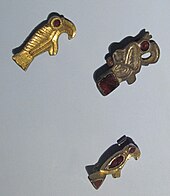Bird fibula
The term bird fibula (origin from the Latin fibula , needle) describes a variant of the small fibulae of the Merovingian and Great Migration Periods in Europe.
These are bird-shaped robe needles cast from bronze , silver or, very rarely, gold . These served as a fastener for outer clothing, as preserved textile remains show on archaeological finds .

Bird fibulae consist of a plate in the shape of a bird, under which a needle with a spiral and a needle holder form the closure, similar to a brooch or safety pin.
The bird shape of the fibula found a regionally and temporally strongly changing design, for example, in the Thuringian Empire, bird fibulae decorated with notches were particularly widespread (see picture). The entire surface or just the bird's eye could be covered with almandines .
literature
- Heinrich Beck (Ed.): Fibel and Fibeltracht. Reallexikon der Germanischen Altertumskunde, Berlin 2000 ISBN 3-11-016858-8
- Ernst-Günter Strauss: Studies on the fibula costume of the Merovingian period. Dr. Rudolf Habelt, Bonn 1992 ISBN 3-7749-2590-9

